
Kroger Field, also known as Commonwealth Stadium, is a stadium in Lexington, Kentucky, United States, located on the campus of the University of Kentucky that primarily serves as the home field for the Kentucky Wildcats football team. The stadium is located at the corner of Alumni Drive and University Drive in Lexington. The playing surface is named C.M. Newton Grounds in honor of retired UK athletic director and former baseball and basketball player C.M. Newton. Built in 1973, it is the newest football stadium in the Southeastern Conference, as measured by date of original construction. The original capacity for the stadium was 57,800. In the stadium's first game, played on September 15, 1973, the Wildcats defeated the Virginia Tech Hokies 31–26.
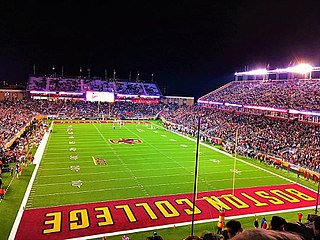
Alumni Stadium is a football stadium located on the lower campus of Boston College in Chestnut Hill, Massachusetts, approximately 6 miles (9.7 km) west of downtown Boston. It is the home of the Boston College Eagles. Its present seating capacity is 44,500. Officially, the stadium is part of the Brighton neighborhood of Boston, although it has a Chestnut Hill address.

Skelly Field at H. A. Chapman Stadium is an outdoor college football stadium in the south central United States, located on the campus of the University of Tulsa in Tulsa, Oklahoma. Commonly known as H. A. Chapman Stadium, it is the home field for the Tulsa Golden Hurricane of the American Athletic Conference.

Fred C. Yager Stadium is a football stadium in Oxford, Ohio, United States. It is home to the Miami University RedHawks football team. It has a capacity of 24,286 spectators, and was built in 1983. It replaced Miami Field, which had been used since 1895 and was the home field for many of the coaches who had made the school famous. The stadium is named for Fred C. Yager, class of 1914, who was the lead benefactor in the project to build the stadium.
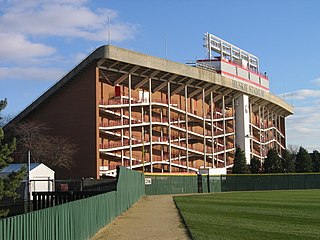
Brigham Field at Huskie Stadium is a college football stadium in the central United States, located on the campus of Northern Illinois University in DeKalb, Illinois. Opened 58 years ago in 1965, it is the home field of the NIU Huskies of the Mid-American Conference (MAC).

War Memorial Stadium, also known as Jonah Field at War Memorial Stadium, is an outdoor college football stadium in the western United States, located on the campus of the University of Wyoming in Laramie.

Kramer/Deromedi Field at Kelly/Shorts Stadium is an American football stadium in Mount Pleasant, Michigan. It serves as the home field for the Central Michigan University Chippewas. The stadium opened in 1972 and holds 30,255 spectators, making it the largest on-campus stadium in the Mid-American Conference. It is located on the southeast part of campus, along with most of the other athletic facilities. The playing surface is named Kramer/Deromedi Field after former coaches Roy Kramer and Herb Deromedi.

Waldo Stadium is a stadium in Kalamazoo, Michigan. It is primarily used for football, and has been the home of Western Michigan University Broncos football in rudimentary form since 1914, and as a complete stadium since 1939. It currently has a capacity of 30,200 spectators.
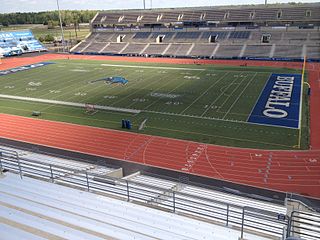
UB Stadium is a stadium in Amherst, New York on the campus of the University at Buffalo. It is primarily used for football, soccer, and track and field events, and is the home field of the Buffalo Bulls. It opened on September 4, 1993, with a game against the University of Maine.
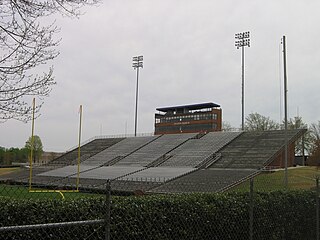
Paladin Stadium is a 16,000-seat stadium located near Greenville, South Carolina, USA. It was built in 1981 at a cost of $2 million, and originally seated 13,200 fans. It was expanded to its current capacity in 1985, and is currently home to the Furman Paladins football team. The stadium was converted to field turf before the 2013 season.
Plaster Stadium is a 17,500-seat football stadium located in Springfield, Missouri. It is home to the Missouri State Bears football team.

Arthur L. Williams Stadium is a 25,000-seat football stadium located on the campus of Liberty University in Lynchburg, Virginia, USA. The stadium was built in 1989 and plays host to Liberty Flames football, which is a part of the NCAA Division I - Football Bowl Subdivision (FBS). A new field house has recently been constructed at the north end of the stadium. This new facility houses a new home locker room, coaches offices, meeting rooms and training facility as well as a 16,000-square-foot (1,500 m2) weight room. In the 2009 off season, Liberty University added a video scoreboard on the north end of the field. The video scoreboard measured 20 feet (6 m) tall and 36 feet (11 m) wide. This video board was replaced by a massive new high-definition video board in time for the 2018 football season.
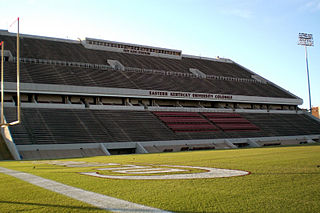
CG Bank Field at Roy Kidd Stadium is Eastern Kentucky University's football stadium in Richmond, Kentucky. The stadium is home to the EKU Colonels football team, located on campus. Currently, CG Bank Field at Roy Kidd Stadium consists of upper and lower-level seating areas with a predominant majority of the seats being metal bleachers. Reserved chairback seats can be found in the middle of the lower level, as well, the seats are generally purchased by season ticket holders and Eastern Alumni.

Allen E. Paulson Stadium is a 25,000-seat on-campus football stadium in Statesboro, Georgia. It is home to the Georgia Southern Eagles football team and the focal point of Erk Russell Athletic Park.
Bob Waters Field at E. J. Whitmire Stadium is a 13,742-seat football stadium in Cullowhee, North Carolina. It opened in 1974 and is home to the Western Carolina University Catamounts football team. The field itself is named Bob Waters Field. The football facility is located on the south end of the WCU campus and is bordered by Cullowhee Creek on the west side; Jordan-Phillips Field House and WCU Weight Room on its north end, and the Liston B. Ramsey Regional Activity Center on the south end.

Nottingham Field is an 8,533-seat multi-purpose stadium in the western United States, located on the campus of the University of Northern Colorado in Greeley, Colorado. It is home to the Northern Colorado Bears football and track and field programs.

Bowen Field House is a 5,400-seat multi-purpose arena in Ypsilanti, Michigan on the Eastern Michigan University campus. It opened in 1955 and was home to the Eastern Michigan Eagles men's and women's basketball teams until the Convocation Center opened in 1997. It currently serves as the home of Eastern Michigan Eagles track and field, Eastern Michigan Eagles wrestling, and Eastern Michigan Eagles gymnastics.

Truist Field at Wake Forest is a football stadium in Winston-Salem, North Carolina. The stadium is just west of Gene Hooks Field at Wake Forest Baseball Park, home of the Wake Forest baseball team. It is primarily used for American football, and is the home field of the Wake Forest University Demon Deacons. The stadium opened in 1968 and holds 31,500 people. It is the smallest football stadium, by capacity, in both the ACC and in all Power 5 conferences. Previously known as Groves Stadium, in September 2007, Wake Forest University and BB&T, which was headquartered in Winston-Salem, announced a 10-year deal to officially rename the stadium BB&T Field starting with the first 2007 home game against Nebraska. The deal was part of a larger development process to secure funds for stadium renovations and upgrades. On July 8, 2020, the name of the stadium was changed to Truist Field at Wake Forest following a merger between BB&T and SunTrust.

Morse Field at Harold Alfond Sports Stadium is a 10,000-seat multi-purpose stadium in Orono, Maine. The stadium opened as Alumni Field in 1947 and underwent extensive renovations from 1996 to 1998. It is home to the University of Maine Black Bears football team. The wood and steel grandstands, built in the 1940s, were condemned and demolished in 1996, replaced with the current east grandstand, along with a temporary structure on the west side, adjacent to Alfond Arena. The current west grandstand, lights, press and luxury levels, as well as concessions and restroom amenities were completed prior to the 1998 season. The stadium was rededicated to Harold Alfond, a longtime Maine booster, at Maine's first home night game on September 12, 1998, a 52–28 win over New Hampshire in the Battle for the Brice-Cowell Musket. The field is named for Phillip and Susan Morse, who donated the lights, original Astroturf and scoreboard. In the summer of 2008, new FieldTurf was installed to replace the old AstroTurf. In 2014, a 20-by-32-foot HD video-board replaced the matrix display installed in 1998, and a contemporary scoreboard was installed on the north end.

Albertsons Stadium is an outdoor athletic stadium in the western United States, located on the campus of Boise State University in Boise, Idaho. It is the home field of the Boise State Broncos of the Mountain West Conference. Known as Bronco Stadium for its first 44 seasons, it was renamed in May 2014 when Albertsons, a chain of grocery stores founded by Boise area resident Joe Albertson, purchased the naming rights.
























